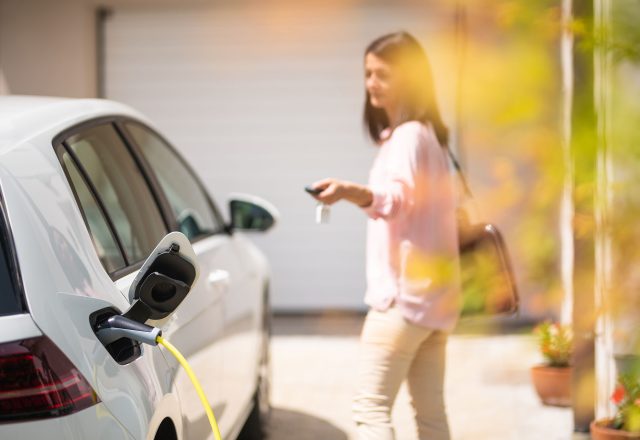It’s ready, set, go in terms of subsidies: anyone planning to convert their fleet of combustion vehicles to an e-fleet can also avail of a range of financial supports to establish their own charging infrastructure. We provide a general overview here.

There is no resisting the e-revolution in fleet operation by the way. Rather fleet managers need to adopt a can-do attitude. In this respect, the management part of the job description has perhaps never been so pronounced as with this critical project. That’s because in many respects the switch is proving not only complex but also budget-intensive. All the better, then, that the public sector is offering robust support for fleet managers. In the first part of our special on establishing your own fleet charging infrastructure, we therefore take a look at the different funding opportunities available for charging stations etc.
In a nutshell: a procedure as unbureaucratic and transparent as exists for procuring electric vehicles is unfortunately lacking when it comes to subsidising a non-public charging infrastructure. While fleet managers can count on flat-rate bonuses of up to €9,000 per all-electric vehicle in 2022 thanks to the innovation premium1), formerly called the scrappage scheme , they can expect a somewhat more extensive costing exercise when setting up a charging system.

The picture shows the ID. Charger from Volkswagen Group Charging GmbH (Elli)
Financing support via the KfW
The federal government has put together its most lavish package of subsidies via the Kreditanstalt für Wiederaufbau (KfW). Thanks to reduced interest loans (0.04% APR, climate subsidy of up to 3%, maximum €25 million) for municipal and medium-sized enterprises, it is possible to raise the money for charging points and backend systems quickly in many cases. Until recently, company car drivers could also avail of a €900 direct bonus from the German state-owned investment and development bank for installing a home charging station, though the budgeted funds have been exhausted for the time being as of November 2021.
Through its electric mobility funding guideline, the Federal Ministry of Transport (BMVI) is also providing funding for the electrification of companies, research institutions, universities, municipalities, public institutions as well as associations and societies. Fleet managers who want to invest in their charging infrastructure can also potentially benefit from the various time-limited funding calls managed by NOW GmbH (National Organization Hydrogen and Fuel Cell Technology), though the focus is shifting in this respect as of November 2021. Companies from the social and health care sector, in particular, such as retirement homes, day care centres and nursing services, which are entitled to avail of what is known as De Minimis aid, can in turn benefit from the “Sozial & Mobil” fleet replacement programme offered by the Federal Ministry for the Environment (BMU). Funding of €1,500 is available per home charging station and €2,500 per charging station.
Some federal states are leading the way
The state of Baden-Württemberg provides €2,500 per charging point through its “Charge@BW” funding programme . The equivalent in Berlin is called “Wirtschaftsnahe Elektromobilität”, or WELMO for short. The Senate Administration in Berlin is offering up to 50% of the total cost of purchasing or leasing a quick-charging infrastructure, for example, up to a maximum of €30,000. Co-financing of the connection is likewise possible. Hamburg subsidises hardware, structural measures, installation and operation of charging points by up to 60%. And Mecklenburg-Vorpommern provides support for local companies to develop their infrastructure by covering up to 30% of the costs. North Rhine-Westphalia is also well placed and provides up to 50% for infrastructure measures plus a bonus for in-house green electricity production and electricity storage.
It will also be exciting to see what the new federal government is planning in terms of electric mobility subsidies. After its round of exploratory talks, the coalition of SPD, Greens and FDP is in any case promising a massively accelerated expansion of the charging infrastructure. The support to be provided to companies, however, was not indicated in the paper published in October 2021. The prospects of what is to come are therefore – literally – electrifying …
Status: 28. January 2022
© Volkswagen AG
1) As of 3 January 2022, the environmental bonus for electric vehicles included on the list of eligible vehicles from the BAFA at the time of application currently consists of a government share amounting to two-thirds that is provided by the BAFA, Department 422, Frankfurter Straße 29-35, 65760 Eschborn, www.bafa.de, and one-third that is provided by the car manufacturer, provided that the vehicle is registered between 3 June 2020 and 31 December 2022. The acquisition (purchase or leasing) may not be subsidised at the same time by other public funds, unless the respective funding body has concluded an administrative agreement with the Federal Ministry for Economic Affairs and Energy. Those entitled to apply include private individuals, companies, foundations, corporations and associations. The vehicle must be registered to the applicant for at least six months in Germany. If the vehicle is leased, the full subsidy amount in each case can only be granted following a lease term of at least 24 months. The environmental bonus will end once the funding is depleted.
When you purchase or lease a new all-electric vehicle, the environmental bonus for basic models up to a net list price of €40,000 set by the BAFA currently amounts to €9,000 (with the government paying twice as much as the manufacturer: €6,000 vs. €3,000). From more than €40,000 to a maximum of €65,000, the bonus currently amounts to €7,500 (with the government paying twice as much as the manufacturer: €5,000 vs. €2,500), provided that the vehicle is registered for road traffic for the first time.
When you purchase or lease a new hybrid electric vehicle, the environmental bonus for basic models up to a net list price of €40,000 set by the BAFA currently amounts to €6,750 (with the government paying twice as much as the manufacturer: €4,500 vs. €2,250). From more than €40,000 to a maximum of €65,000, the bonus currently amounts to €5,625 (with the government paying twice as much as the manufacturer: €3,750 vs. €1,875), provided that the vehicle is registered for road traffic for the first time.
When you purchase or lease a used all-electric vehicle, the environmental bonus currently amounts to €7,500 (with the government paying twice as much as the manufacturer: €5,000 vs. €2,500), while for a used hybrid electric vehicle, the bonus currently amounts to €5,625 (with the government paying twice as much as the manufacturer: €3,750 vs. €1,875). The vehicle must have been first registered in the EU after 4 November 2019 and for the second time between 3 June 2020 and 31 December 2022. The vehicle may have been registered first for a period of at most 12 months and must have mileage of less than 15,000 km. The vehicle may not yet be subsidised by the environmental bonus or a comparable government subsidy in another member state of the EU. The environmental bonus can be granted if the purchase price of the used vehicle has reached a maximum threshold value formed by 80% of the list price of the new vehicle (gross, including optional equipment and excluding discounts) less the manufacturer’s gross share. The same applies to leased vehicles.
The manufacturer’s share paid by Volkswagen AG is automatically deducted from the net list price, lowering the statutory VAT due. The granting of the manufacturer’s share of the environmental bonus does not automatically entitle the purchaser to receive the government share.
The BAFA will base its approval of the payment solely on the scheme’s terms and conditions and on your application. The application for the government share of the environmental bonus must be submitted at the latest one year following registration using the electronic application form at www.bafa.de. Applications for subsidies where the government share is twice that of the manufacturer (innovation premium) must be submitted to BAFA no later than 31 December 2022.
The granting of the environmental bonus when purchasing or leasing a new all-electric vehicle or hybrid electric vehicle with equal government and manufacturer shares ends at the latest on 31 December 2025.
A legal entitlement does not exist. The statements contained in this document are intended for information purposes only and do not purport to be complete. All information is subject to change or correction. Further information is available from your Volkswagen Partner or at www.bafa.de.










